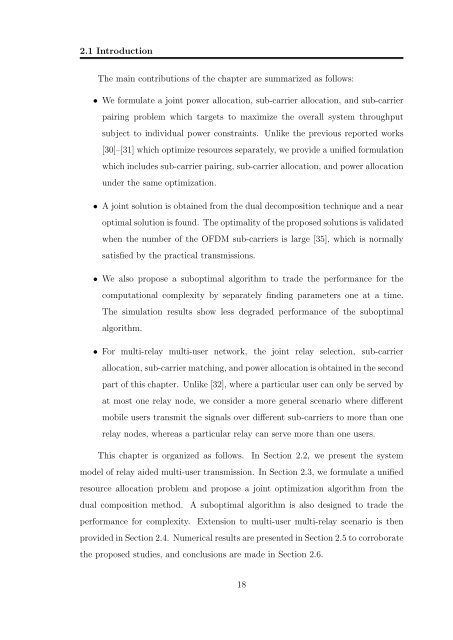Resource Allocation in OFDM Based Wireless Relay Networks ...
Resource Allocation in OFDM Based Wireless Relay Networks ...
Resource Allocation in OFDM Based Wireless Relay Networks ...
You also want an ePaper? Increase the reach of your titles
YUMPU automatically turns print PDFs into web optimized ePapers that Google loves.
2.1 Introduction<br />
The ma<strong>in</strong> contributions of the chapter are summarized as follows:<br />
• We formulate a jo<strong>in</strong>t power allocation, sub-carrier allocation, and sub-carrier<br />
pair<strong>in</strong>g problem which targets to maximize the overall system throughput<br />
subject to <strong>in</strong>dividual power constra<strong>in</strong>ts. Unlike the previous reported works<br />
[30]–[31] which optimize resources separately, we provide a unified formulation<br />
which <strong>in</strong>cludes sub-carrier pair<strong>in</strong>g, sub-carrier allocation, and power allocation<br />
under the same optimization.<br />
• A jo<strong>in</strong>t solution is obta<strong>in</strong>ed from the dual decomposition technique and a near<br />
optimal solution is found. The optimality of the proposed solutions is validated<br />
when the number of the <strong>OFDM</strong> sub-carriers is large [35], which is normally<br />
satisfied by the practical transmissions.<br />
• We also propose a suboptimal algorithm to trade the performance for the<br />
computational complexity by separately f<strong>in</strong>d<strong>in</strong>g parameters one at a time.<br />
The simulation results show less degraded performance of the suboptimal<br />
algorithm.<br />
• For multi-relay multi-user network, the jo<strong>in</strong>t relay selection, sub-carrier<br />
allocation, sub-carrier match<strong>in</strong>g, and power allocation is obta<strong>in</strong>ed <strong>in</strong> the second<br />
part of this chapter. Unlike [32], where a particular user can only be served by<br />
at most one relay node, we consider a more general scenario where different<br />
mobile users transmit the signals over different sub-carriers to more than one<br />
relay nodes, whereas a particular relay can serve more than one users.<br />
This chapter is organized as follows. In Section 2.2, we present the system<br />
model of relay aided multi-user transmission. In Section 2.3, we formulate a unified<br />
resource allocation problem and propose a jo<strong>in</strong>t optimization algorithm from the<br />
dual composition method. A suboptimal algorithm is also designed to trade the<br />
performance for complexity. Extension to multi-user multi-relay scenario is then<br />
provided <strong>in</strong> Section 2.4. Numerical results are presented <strong>in</strong> Section 2.5 to corroborate<br />
the proposed studies, and conclusions are made <strong>in</strong> Section 2.6.<br />
18

















